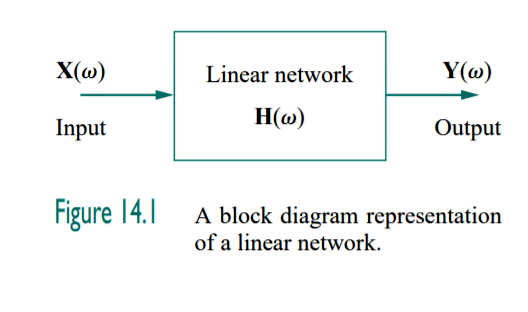The transfer function H(ω) (also called the network function) is a useful
analytical tool for finding the frequency response of a circuit.
In fact, the frequency response of a circuit is the plot of the circuit’s transfer function
H(ω) versus ω, with ω varying from ω = 0 to ω = ∞.
It is the frequency-dependent ratio of a forced
function to a forcing function (or of an output to an input).
The idea of a transfer function was implicit when we used the concepts of impedance
and admittance to relate voltage and current.

“The transfer function H(ω) of a circuit is the frequency-dependent ratio of a
phasor output Y(ω) (an element voltage or current) to a phasor input
X(ω) (source voltage or current).“
Thus,
H(ω) = Y(ω)/X(ω) (14.1)
assuming zero initial conditions.
Since the input and output can be either voltage or current at any place in the circuit.
There are 4 possible transfer functions:

where subscripts i and o denote input and output values.
Where H(ω) = H (ω) ∠φ.
How to obtain Transfer function equation?
To obtain the equation using Eq. (14.2), we first obtain
the frequency-domain equivalent of the circuit by replacing resistors,
inductors, and capacitors with their impedances R, jωL, and 1/jωC.
We then use any circuit technique(s) to obtain the appropriate quantity in
Eq. (14.2).
We can obtain the frequency response of the circuit by plotting
the magnitude and phase of the transfer function as the frequency varies.
Moreover, a computer is a real time-saver for plotting this function.
The transfer function H(ω) can be expressed as
H(ω) = N(ω)/D(ω) (14.3)
where N(ω) and D(ω) are not necessarily the same expressions for the
input and output functions.
Therefore, the expression of H(ω) in Eq. (14.3) assumes that common numerator and denominator factors in H(ω) have canceled,
reducing the ratio to the lowest terms.
The roots of N(ω) = 0 are called the zeros of H(ω) & are usually represented as
jω = z1, z2,..
Similarly, the roots of D(ω) = 0 are the poles of H(ω) & are represented as jω = p1, p2,..
“A zero, as a root of the numerator polynomial, is a value that results in a zero
value of the function. A pole, as a root of the denominator polynomial,
is a value for which the function is infinite.”
Also, visit our website for such useful notes
Checkout >> Zener diode & it’s working
Types of Transistors – BJT & FET





